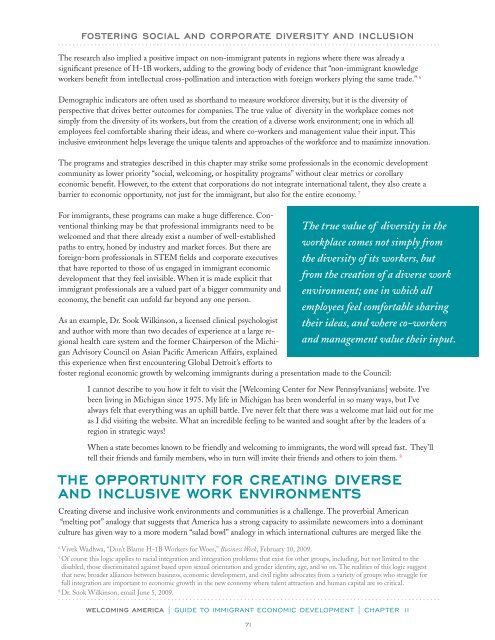IMMIGRANT
npjjbma
npjjbma
- No tags were found...
You also want an ePaper? Increase the reach of your titles
YUMPU automatically turns print PDFs into web optimized ePapers that Google loves.
FOSTERING SOCIAL AND CORPORATE DIVERSIT Y AND INCLUSIONThe research also implied a positive impact on non-immigrant patents in regions where there was already asignificant presence of H-1B workers, adding to the growing body of evidence that “non-immigrant knowledgeworkers benefit from intellectual cross-pollination and interaction with foreign workers plying the same trade.” 6Demographic indicators are often used as shorthand to measure workforce diversity, but it is the diversity ofperspective that drives better outcomes for companies. The true value of diversity in the workplace comes notsimply from the diversity of its workers, but from the creation of a diverse work environment; one in which allemployees feel comfortable sharing their ideas, and where co-workers and management value their input. Thisinclusive environment helps leverage the unique talents and approaches of the workforce and to maximize innovation.The programs and strategies described in this chapter may strike some professionals in the economic developmentcommunity as lower priority “social, welcoming, or hospitality programs” without clear metrics or corollaryeconomic benefit. However, to the extent that corporations do not integrate international talent, they also create abarrier to economic opportunity, not just for the immigrant, but also for the entire economy. 7For immigrants, these programs can make a huge difference. Conventionalthinking may be that professional immigrants need to bewelcomed and that there already exist a number of well-establishedpaths to entry, honed by industry and market forces. But there areforeign-born professionals in STEM fields and corporate executivesthat have reported to those of us engaged in immigrant economicdevelopment that they feel invisible. When it is made explicit thatimmigrant professionals are a valued part of a bigger community andeconomy, the benefit can unfold far beyond any one person.The true value of diversity in theworkplace comes not simply fromthe diversity of its workers, butfrom the creation of a diverse workenvironment; one in which allemployees feel comfortable sharingtheir ideas, and where co-workersand management value their input.As an example, Dr. Sook Wilkinson, a licensed clinical psychologistand author with more than two decades of experience at a large regionalhealth care system and the former Chairperson of the MichiganAdvisory Council on Asian Pacific American Affairs, explainedthis experience when first encountering Global Detroit’s efforts tofoster regional economic growth by welcoming immigrants during a presentation made to the Council:I cannot describe to you how it felt to visit the [Welcoming Center for New Pennsylvanians] website. I’vebeen living in Michigan since 1975. My life in Michigan has been wonderful in so many ways, but I’vealways felt that everything was an uphill battle. I’ve never felt that there was a welcome mat laid out for meas I did visiting the website. What an incredible feeling to be wanted and sought after by the leaders of aregion in strategic ways!When a state becomes known to be friendly and welcoming to immigrants, the word will spread fast. They’lltell their friends and family members, who in turn will invite their friends and others to join them. 8The Opportunit y for Creating Diverseand Inclusive Work EnvironmentsCreating diverse and inclusive work environments and communities is a challenge. The proverbial American“melting pot” analogy that suggests that America has a strong capacity to assimilate newcomers into a dominantculture has given way to a more modern “salad bowl” analogy in which international cultures are merged like the6 Vivek Wadhwa, “Don’t Blame H-1B Workers for Woes,” Business Week, February 10, 2009.7 Of course this logic applies to racial integration and integration problems that exist for other groups, including, but not limited to thedisabled, those discriminated against based upon sexual orientation and gender identity, age, and so on. The realities of this logic suggestthat new, broader alliances between business, economic development, and civil rights advocates from a variety of groups who struggle forfull integration are important to economic growth in the new economy where talent attraction and human capital are so critical.8 Dr. Sook Wilkinson, email June 5, 2009.WELCOMING AMERICA | GUIDE TO <strong>IMMIGRANT</strong> ECONOMIC DEVELOPMENT | CHAPTER 1171


